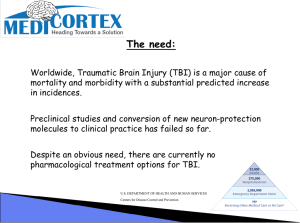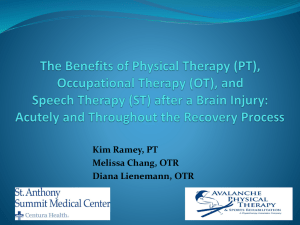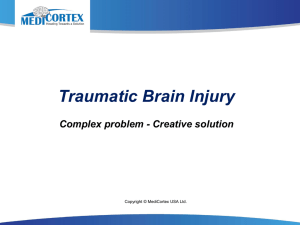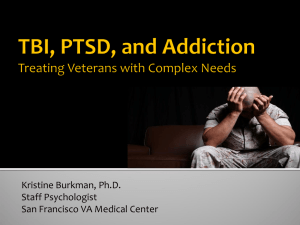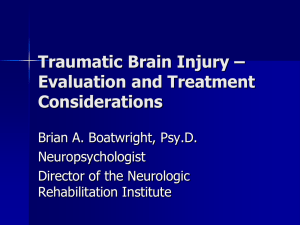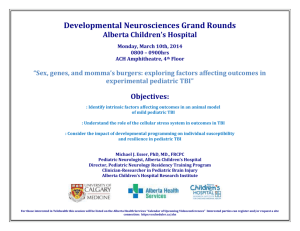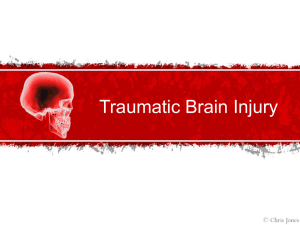Traumatic Hypoxia and Cerebral Inflammation
advertisement
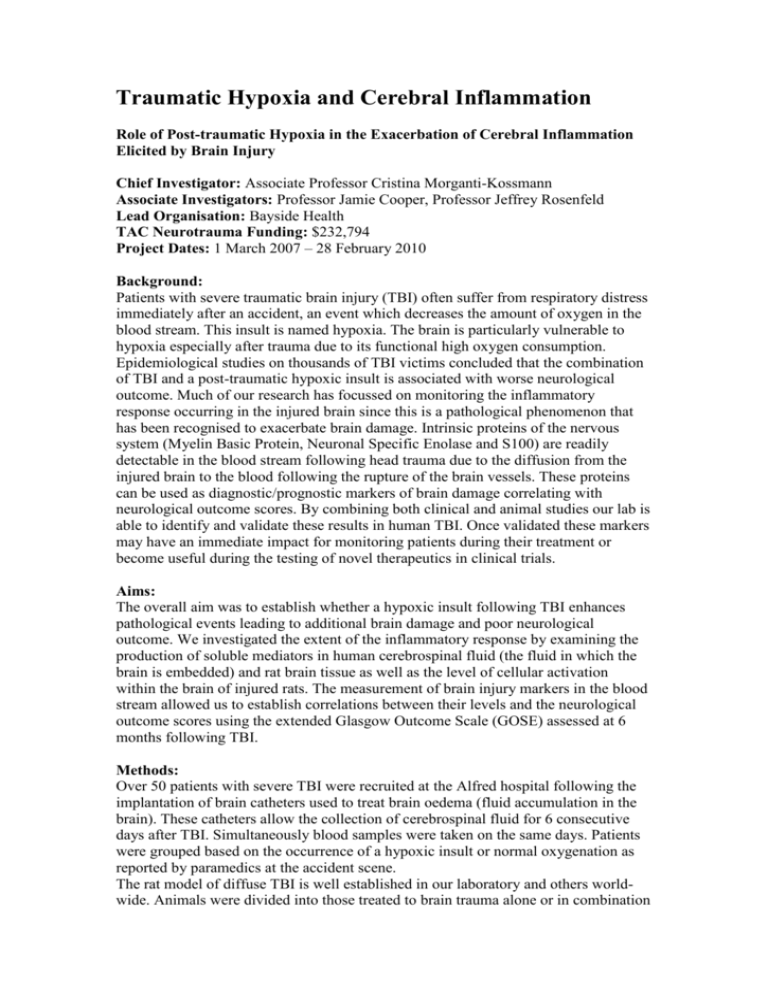
Traumatic Hypoxia and Cerebral Inflammation Role of Post-traumatic Hypoxia in the Exacerbation of Cerebral Inflammation Elicited by Brain Injury Chief Investigator: Associate Professor Cristina Morganti-Kossmann Associate Investigators: Professor Jamie Cooper, Professor Jeffrey Rosenfeld Lead Organisation: Bayside Health TAC Neurotrauma Funding: $232,794 Project Dates: 1 March 2007 – 28 February 2010 Background: Patients with severe traumatic brain injury (TBI) often suffer from respiratory distress immediately after an accident, an event which decreases the amount of oxygen in the blood stream. This insult is named hypoxia. The brain is particularly vulnerable to hypoxia especially after trauma due to its functional high oxygen consumption. Epidemiological studies on thousands of TBI victims concluded that the combination of TBI and a post-traumatic hypoxic insult is associated with worse neurological outcome. Much of our research has focussed on monitoring the inflammatory response occurring in the injured brain since this is a pathological phenomenon that has been recognised to exacerbate brain damage. Intrinsic proteins of the nervous system (Myelin Basic Protein, Neuronal Specific Enolase and S100) are readily detectable in the blood stream following head trauma due to the diffusion from the injured brain to the blood following the rupture of the brain vessels. These proteins can be used as diagnostic/prognostic markers of brain damage correlating with neurological outcome scores. By combining both clinical and animal studies our lab is able to identify and validate these results in human TBI. Once validated these markers may have an immediate impact for monitoring patients during their treatment or become useful during the testing of novel therapeutics in clinical trials. Aims: The overall aim was to establish whether a hypoxic insult following TBI enhances pathological events leading to additional brain damage and poor neurological outcome. We investigated the extent of the inflammatory response by examining the production of soluble mediators in human cerebrospinal fluid (the fluid in which the brain is embedded) and rat brain tissue as well as the level of cellular activation within the brain of injured rats. The measurement of brain injury markers in the blood stream allowed us to establish correlations between their levels and the neurological outcome scores using the extended Glasgow Outcome Scale (GOSE) assessed at 6 months following TBI. Methods: Over 50 patients with severe TBI were recruited at the Alfred hospital following the implantation of brain catheters used to treat brain oedema (fluid accumulation in the brain). These catheters allow the collection of cerebrospinal fluid for 6 consecutive days after TBI. Simultaneously blood samples were taken on the same days. Patients were grouped based on the occurrence of a hypoxic insult or normal oxygenation as reported by paramedics at the accident scene. The rat model of diffuse TBI is well established in our laboratory and others worldwide. Animals were divided into those treated to brain trauma alone or in combination with a 30 minute hypoxic insult immediately after TBI. For control purposes, two groups were generated, one with hypoxia alone and another with anaesthesia and surgical procedures but without trauma (sham). In humans, the concentration of 9 immune mediators or cytokines was measured in the brain fluid for 6 consecutive days whereas in the rat these mediators were measured in brain tissue samples at 5 time points over 4 days. Additionally rat brain sections were stained to quantify the infiltration of blood cells into the brain tissue and examine axonal damage, glial activation, size of the ventricles and brain oedema. In both humans and animals the neurological deficit was assessed to determine post-TBI and hypoxia outcome. In the patients the extended Glasgow Outcome Scale at 6 months post-TBI was used, whereas in rats a variety of established tests including the rotarod, sticky tape removal, beam walk and open field tests were employed for 14 days post-injury. Results: Systemic hypoxia in rats was confirmed by the reduction of oxygen by 50% and blood oxygenation (pO2) by 75% in arterial blood during the exposure to low (12%) Oxygen. This also coincided with an increase in lactate blood levels and reduction in mean arterial blood pressure. With the sensorimotor tests rats subjected to combined TBI and hypoxia showed a more severe deficit in the rotarod during the 6 to 8 days post-injury. In the open field test the distance travelled was significantly reduced in rats subjected to TBI and Hypoxia (TBI+Hx) as compared to TBI alone. In the rat brain, the concentration of pro-inflammatory cytokines interleukin-1 (IL-1), IL-6, and tumor necrosis factor (TNF) was found exacerbated in the TBI+Hx group as compared to TBI alone at specific early timepoints (2-24 hours), while IL-2, IL-4 and IL-10 did not change in any of the groups. Brain oedema increased in both TBI and TBI+Hx rats but there were no differences between treatments. The enlargement of the ventricle size occurred in all TBI groups at 1 and 7 days but was more pronounced at 1 day in TBI+Hx rats. Axonal damage detected with the marker amyloid precursor protein (APP) showed the presence of axonal swelling and bulb formation which was exacerbated following TBI+Hx at 1 and 7 days in the corpus callosum and brain stem which are regions rich in myelin and axonal bundles. Similarly, the infiltration of blood macrophages and the activation of glial cells were also more pronounced in the brain of TBI+Hx rats as compared to TBI rats. In the human study, all cytokines were found increased after TBI in the cerebrospinal fluid (CSF). However differences between cytokine levels were only found when patients with focal brain injury were compared with diffuse brain injury. In the latter, injury markers interleukin-2 and interleukin-4 (IL-2 and IL-4) were found more elevated than in the focal group. Overall, two injury markers, myelin basic protein (MBP) and S100 protein were found more elevated in the serum of TBI+Hx group over the TBI alone group. Also, the increased concentration of S100 correlated to a poorer Neurological outcome (lower GOSE score) in the TBI+Hx group. NSE levels showed the weakest correlations to outcome as compared to the other markers S-100 and MBP. Generally, stronger correlations were found when comparing diffuse with focal brain injured patients, with an increased presence of S100 protein coinciding with a lower GOSE score in the diffuse TBI group. MBP correlated with outcome in both focal and diffuse TBI; however it showed a stronger correlation in the focal group. In the focal TBI patients all three injury markers were found in blood serum at higher levels than the focal TBI patients. Conclusions: We found that post-traumatic hypoxia has a significant impact in exacerbating neurological deficit, secondary brain damage and neuroinflammation particularly in the animal experiments, where it was possible to standardise the severity and type of brain trauma. In the patient study more reliable cytokine data were obtained by comparing different patterns of brain damage (focal versus diffuse) rather than examining the effect of post-traumatic hypoxia. All markers were more elevated in the focal TBI group over diffuse group. Two specific injury markers were found more elevated in the TBI and hypoxia group whereby one of them strongly correlated with a poorer neurological outcome. In future studies, a larger patient sample size would be useful to validate these preliminary results. Publications: MORGANTI-KOSSMANN MC, SATGUNASEELAN L, BYEN, NGUYEN P, KOSSMANN T. Role of the inflammatory process in traumatic brain damage. In: KILPATRICK T, WESSELINGH S, RANSOHOFF R, editors. Neuroinflammation in the brain. Cambridge University Press. 2008. MORGANTI-KOSSMANN MC, SATGUNASEELAN L, BYE N, KOSSMANN T. Modulation of immune response by head injury. Injury. 2007;38(12):1392-1400. HELLEWELL S, YAN E, AGYAPOMAA D, BYE N, MORGANTI-KOSSMANN MC. Posttraumatic hypoxia exacerbates brain tissue damage: Analysis of axonal injury and glial responses. J Neurotrauma. 2010;27(11):1997-2010. MORGANTI-KOSSMANN MC, YAN E, BYE N. Animal models of traumatic brain injury: Is there an optimal model to reproduce human brain injury in the laboratory? Injury. 2010;41:Suppl 1:S10-3. Presentations: SATGUNASEELAN L, YAN E, BYE B, NGUYEN P, AGYAPOMAA D, KOSSMANN T, ROSENFELD JV, COOPER J, MORGANTI-KOSSMANN MC. The effect of post-traumatic hypoxia on neuroinflammation, protein maker release and brain metabolism after traumatic brain injury. Neurosurgical Society Australasia Annual Conference; 2007, Gold Coast, Australia. SATGUNASEELAN L, NGUYEN P, AGYAPOMAA D, KOSSMANN T, MORGANTIKOSSMANN MC. The effect of post-traumatic hypoxia (PTH) on neuroinflammation, protein marker release and brain metabolism after traumatic brain injury (TBI). 7th International Brain Research Organization World Congress; 2007 July 12-16, Melbourne, Australia. YAN EB, WALKER DW, ROSENFELD J, SEIFMAN M, COOPER J, MORGANTI-KOSSMANN MC. Hypoxia following traumatic brain injury alters the tryptophan metabolism and melatonin productions in the patients. Sixth Australian Conference on the Kynurenine Pathway of Tryptophan Metabolism; 2007, Sydney, Australia. SATGUNASEELAN L, YAN EB, NGUYEN P, AGYAPOMAA D, KOSSMANN T, MORGANTIKOSSMANN MC. Monitoring the neuroinflammatory response in traumatic brain injury using microdialysis: an experimental model. International Conference on Clinical Microdialysis; 2007, Cambridge, UK. SATGUNASEELAN L, NGUYEN P, BYE N, AGYAPOMAA D, KOSSMANN T, MORGANTIKOSSMANN MC. The diagnostic role of protein markers and cytokines in focal and diffuse traumatic brain injury (TBI). 7th International Brain Research Organization World Congress; 2007 July 12-16, Melbourne, Australia. HELLEWELL SC, YAN EB, AGYAPOMAA D, MORGANTI-KOSSMANN MC. Post-traumatic hypoxia worsens neuropathological damage in an animal model of diffuse axonal injury. Trauma Melbourne; 2008 November 21-22, Melbourne, Australia. YAN EB, WALKER DW, AGYAPOMMA D, GUILLEMIN GJ, MORGANTI-KOSSMANN MC. Increase tryptophan metabolism after traumatic brain injury. Trauma Melbourne; 2008 November 2122, Melbourne, Australia. SATGUNASEELAN L, YAN EB, AGYAPOMAA D, NGUYEN P, KOSSMAN T, COOPER DJ, VALLANCE S, MORGANTI-KOSSMANN MC. Measurement of brain specific proteins in traumatic brain injury (TBI)- A role for outcome prediction? Trauma Melbourne; 2008 November 21-22, Melbourne, Australia. YAN EB, SATGUNASELLAN L, NGUYEN P, BYE N, WALKER DW, AGYAPOMAA D, ROSENFELD J, SEIFMAN M, KOSSMANN T, MORGANTI-KOSSMANN MC. The effect of posttraumatic hypoxia on neuroinflammation, tryptophan oxidation and melatonin production after traumatic brain injury Australian neuroscience Society 28th Annual Meeting; 2008, Hobart, Australia. YAN EB, HELLEWELL SC, AGYAPOMAA D, MORGANTI-KOSSMANN MC. Post-trauma hypoxia exacerbates neurological deficits, neuroinflammation, and axonal damage in a rat model of diffuse axonal injury. Trauma Melbourne; 2009 November 19-21, Melbourne, Australia. ALWIS DS, COLEMAN HC, PARKINGTON HC, ZHANG AM, MORGANTI-KOSSMANN MC, EDWIN B, YAN EB. Diffuse traumatic axonal injury induces sensorimotor deficit, memory loss and hippocampal axonal hyperexcitability. Trauma Melbourne; 2009 November 19-21, Melbourne, Australia. YAN E, HELLEWELL S, AGYAPOMAA D, MORGANTI-KOSSMANN MC. Posttrauma hypoxia exacerbates neurological deficits, neuroinflammation and axonal damage in a rat model of diffuse axonal injury. Joint National/International Neurotrauma Conference; 2009 September 7-11, Santa Barbara, USA. HELLEWELL SC, YAN EB, AGYAPOMMAA D, MORGANTI-KOSSMANN MC. Post-traumatic hypoxia exacerbates brain damage in an animal of diffuse axonal injury. ANS Meeting; 2009 January 27-30, Canberra, Australia. ALWIS, COLEMAN, PARKINGTON, ZHANG, MORGANTI-KOSSMANN, YAN. Diffuse traumatic axonal injury induces sensorimotor deficit, memory loss and hippocampal axonal hyperexcitability. Australian Neuroscience Society; 2010 February 1-3, Sydney, Australia.
